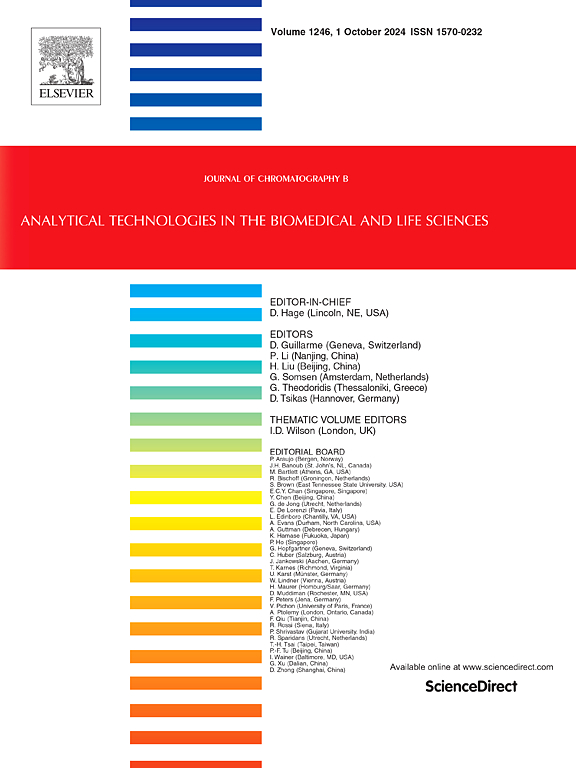Achiral LC-MS/MS and chiral SFC-MS methods for quantification of methoxphenidine and O-desmethyl-methoxphenidine metabolite in rat serum and brain
IF 2.8
3区 医学
Q2 BIOCHEMICAL RESEARCH METHODS
引用次数: 0
Abstract
Methoxphenidine (MXP), a dissociative anaesthetic derivative, has garnered the attention of toxicologists for their increasing abuse and associated toxicity. Despite that there is limited forensic and clinical toxicology data on MXP, especially regarding its metabolism and enantiomers. To fill this gap, we developed, validated and applied achiral liquid chromatography–tandem mass spectrometry (LC-MS/MS) and chiral supercritical fluid chromatography–MS (SFC-MS) methods to quantify MXP and its primary metabolite, O-desmethyl-methoxphenidine (dmMXP), in rat serum and brain samples collected after a single subcutaneous dosing of racemic MXP. Serum samples were extracted by protein precipitation with 0.1 % formic acid in acetonitrile, and salting-out–assisted liquid–liquid extraction was utilised for brain extraction. The samples were analysed by a reversed-phase LC-MS/MS method equipped with a Poroshell 120 phenyl-hexyl column, and the enantioselective SFC-MS method was equipped with an Alcyon Amylose-SA column. Both methods were fully validated according to the European Medicines Agency guidelines. The LC-MS/MS method had a total run time of 4.8 min with a linear response up to 400 ng/mL in serum and 2400 ng/g in brain, and the limits of quantification were 1.00 ng/mL and 6.00 ng/g for MXP and 1.00 ng/mL and 1.50 ng/g for dmMXP. The enantioselective SFC-MS method had a total run time of 15 min, showing linear ranges up to 1000 ng/mL for individual enantiomers in serum and 7200 ng/g in brain. The limits of quantification of (R,S)-MXP were 12.5 ng/mL and 30.0 ng/g, while those of (R,S)-dmMXP were 25.0 ng/mL and 60.0 ng/g. The achiral LC-MS/MS method enabled quantification of racemic MXP and dmMXP, while the chiral SFC-MS method was used only for MXP enantiomers, as its higher lower limit of quantification did not allow for enantioselective quantification of dmMXP. Serum MXP peaked at 1600 ng/mL (0.5 h) and decreased to 5.87 ng/mL at 24 h, while dmMXP peaked at 11.8 ng/mL (1 h) and was below the limit of quantification at 24 h. In brain, MXP peaked at 13200 ng/g (0.5 h) and decreased to 36.1 ng/g (24 h), while dmMXP reached 67.1 ng/g (1 h) and decreased to 1.63 ng/g (24 h). Moreover, it was found that the (S)-MXP concentrations in the brain appeared to be higher than the (R)-enantiomer concentrations. The validated methods allow for the generation of pharmacokinetic curves for MXP within a behavioural study and provide a valuable tool for forensic and clinical toxicology for the study of the dissociative anaesthetic MXP and its metabolite in rat serum and brain.
非手性LC-MS/MS和手性SFC-MS方法定量测定大鼠血清和脑中甲氧苯胺和o -去甲基-甲氧苯胺代谢物
甲氧苯定(MXP)是一种解离性麻醉剂衍生物,因其滥用和相关毒性日益增加而引起毒理学家的注意。尽管关于MXP的法医和临床毒理学数据有限,特别是关于其代谢和对映体。为了填补这一空白,我们开发、验证并应用了非手性液相色谱-串联质谱(LC-MS/MS)和手性超临界液相色谱-质谱(SFC-MS)方法来定量单次皮下给药外消旋MXP后收集的大鼠血清和脑样品中的MXP及其主要代谢物o -去甲基-甲氧苯胺(dmMXP)。血清样品采用0.1%甲酸乙腈蛋白沉淀法提取,脑样品采用盐析辅助液-液萃取法提取。样品的分析采用反相LC-MS/MS法,柱柱为Poroshell 120苯基己基,对映选择性SFC-MS法,柱柱为Alcyon Amylose-SA。根据欧洲药品管理局的指导方针,这两种方法都得到了充分的验证。LC-MS/MS方法总运行时间为4.8 min,血清和脑样品的定量限分别为400 ng/mL和2400 ng/g, MXP的定量限分别为1.00 ng/mL和6.00 ng/g, dmMXP的定量限分别为1.00 ng/mL和1.50 ng/g。对映体选择性SFC-MS方法总运行时间为15分钟,血清中单个对映体的线性范围为1000 ng/mL,脑中为7200 ng/g。(R,S)-MXP的定量限分别为12.5 ng/mL和30.0 ng/g, (R,S)-dmMXP的定量限分别为25.0 ng/mL和60.0 ng/g。非手性LC-MS/MS法可定量外消旋MXP和dmMXP,而手性SFC-MS法仅用于MXP对映体,其定量下限较高,不能对dmMXP进行对映选择性定量。血清MXP峰值为1600 ng/mL (0.5 h), 24 h时降至5.87 ng/mL, dmMXP峰值为11.8 ng/mL (1 h), 24 h时低于定量限。脑内MXP峰值为13200 ng/g (0.5 h), 24 h时降至36.1 ng/g, dmMXP峰值为67.1 ng/g (1 h), 24 h时降至1.63 ng/g。此外,还发现(S)-MXP在大脑中的浓度似乎高于(R)-对映体的浓度。经过验证的方法允许在行为研究中生成MXP的药代动力学曲线,并为分离麻醉剂MXP及其在大鼠血清和大脑中的代谢物的法医和临床毒理学研究提供了有价值的工具。
本文章由计算机程序翻译,如有差异,请以英文原文为准。
求助全文
约1分钟内获得全文
求助全文
来源期刊

Journal of Chromatography B
医学-分析化学
CiteScore
5.60
自引率
3.30%
发文量
306
审稿时长
44 days
期刊介绍:
The Journal of Chromatography B publishes papers on developments in separation science relevant to biology and biomedical research including both fundamental advances and applications. Analytical techniques which may be considered include the various facets of chromatography, electrophoresis and related methods, affinity and immunoaffinity-based methodologies, hyphenated and other multi-dimensional techniques, and microanalytical approaches. The journal also considers articles reporting developments in sample preparation, detection techniques including mass spectrometry, and data handling and analysis.
Developments related to preparative separations for the isolation and purification of components of biological systems may be published, including chromatographic and electrophoretic methods, affinity separations, field flow fractionation and other preparative approaches.
Applications to the analysis of biological systems and samples will be considered when the analytical science contains a significant element of novelty, e.g. a new approach to the separation of a compound, novel combination of analytical techniques, or significantly improved analytical performance.
 求助内容:
求助内容: 应助结果提醒方式:
应助结果提醒方式:


